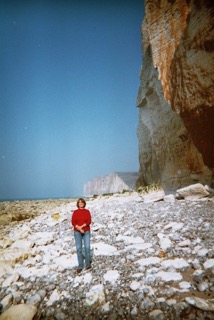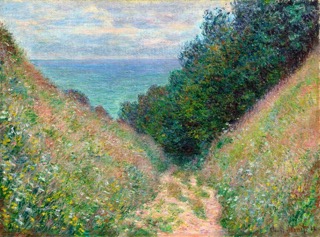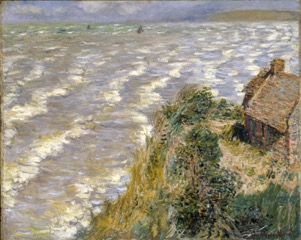Monet Painting by the Sea
 Tuesday, August 15, 2017 at 8:38PM
Tuesday, August 15, 2017 at 8:38PM Continuing our series on ocean people, an homage to ocean artists. Simply looking at paintings and photos of the sea can be calming and inspiring, each brushstroke, each wave. Here are some memories of a seaside trip inspired by Claude Monet.
Claude Monet grew up by the sea, in the Normandy port of Le Havre, where his father was a ship handler, selling boat supplies to fisherman. Monet is best known for his paintings of gardens, water lilies and cathedrals. But his career was born on a beach, and like a migrating bird, he returned to the sea every year to paint wave and rock and light.
Monet’s mother, a singer, supported his desire to become an artist, despite his father’s pressure that he carry on in the handlery business. When he was only 16, on a contemplative beach walk, Monet first met by chance the older painter Eugene Boudin, who taught him how to use oils, and encouraged him in his now famous style of painting outdoors, plein air. At the time most painters worked indoors, and copied old masters; Boudin on the beach suggested to the teen that he paint the same scene over and over, as the light and his impression of that light changed.
Monet’s career in art came with many challenges - poverty, exile during the Franco-Prussian War and rejection by the art establishment. Only in later years was Monet able to settle in a river town, Giverney, when he planted and then painted his famous water lilies and other river scenes. But every year he would travel back to his native Normandy and paint for a few weeks by the sea.
 Monet painted often near the Normandy town of Pourville. I first saw some of these paintings in person in 2013 at an exhibit at the Legion of Honor museum in San Francisco called “Impressionism on the Water” about ocean and river paintings by all kinds of French Impressionists. My daughter Norah, home from college, went with me. We had been talking about how I might go visit her in Scotland where she was studying, the following spring break, March, when it would still be cold and dreary up north. How about France, I said. How about there, said Norah, pointing to the Monet cliffs.
Monet painted often near the Normandy town of Pourville. I first saw some of these paintings in person in 2013 at an exhibit at the Legion of Honor museum in San Francisco called “Impressionism on the Water” about ocean and river paintings by all kinds of French Impressionists. My daughter Norah, home from college, went with me. We had been talking about how I might go visit her in Scotland where she was studying, the following spring break, March, when it would still be cold and dreary up north. How about France, I said. How about there, said Norah, pointing to the Monet cliffs.
I’d been to the big wide Normandy beaches years before. They remind me of the beaches on the New Jersey shore where I spent summers as a child, vast flat expanses of soft sand, dramatic shifts of shoreline from high to low tide. At low tide you can walk far out without having to swim, and there are sand bars. The beaches of Normandy are so wide they invite invasion, so wide there was lots of time and space for the German snipers to pick off those brave young invading men, turning water and beach deep red. Today the beaches are white and clean again, but you need only turn your eyes inland to see extending back from the low cliffs vast miles of cemeteries with rows and rows of crosses.
 But I had not visited Normandy’s cliffside beaches, neither wide nor flat, but rocky, and haunted by towering colorful chalk cliffs. Like the cliffs of Dover just 20 miles north, Normandy’s towering dramatic cliffs and rocky beaches frame and shelter the coast. The danger there is not from invading forces but from tumbling rocks; signs warn “Attention! Risque de chutes de pierre!” with graphic images of boulders falling on beachcombers. That didn’t stop my daughter and me from hiking down these beaches, picking carefully along the rough coast, poking for shells and rock souvenirs.
But I had not visited Normandy’s cliffside beaches, neither wide nor flat, but rocky, and haunted by towering colorful chalk cliffs. Like the cliffs of Dover just 20 miles north, Normandy’s towering dramatic cliffs and rocky beaches frame and shelter the coast. The danger there is not from invading forces but from tumbling rocks; signs warn “Attention! Risque de chutes de pierre!” with graphic images of boulders falling on beachcombers. That didn’t stop my daughter and me from hiking down these beaches, picking carefully along the rough coast, poking for shells and rock souvenirs.
 We approached the beach at Saint Valery-en-Caux along a steep winding canyon with cliffs so high that we could not see the ocean, but trusted the signs and gradually smelled the waves. Monet took a similar route. On this offseason morning we were the only ones of the narrow road, and at the beach the only visitors. A group of loutish French young men with many beer glasses already on their snack bar tables hooted at my nubile daughter and encouraged us to join them pour dejeuner, but they were too lazy to follow us down the beach.
We approached the beach at Saint Valery-en-Caux along a steep winding canyon with cliffs so high that we could not see the ocean, but trusted the signs and gradually smelled the waves. Monet took a similar route. On this offseason morning we were the only ones of the narrow road, and at the beach the only visitors. A group of loutish French young men with many beer glasses already on their snack bar tables hooted at my nubile daughter and encouraged us to join them pour dejeuner, but they were too lazy to follow us down the beach.
The feeling in many of these seaside paintings is of casual freedom, a day without plans or problems. This fit with my daughter’s teenage mood – no planning. “Oh Mom let’s just drive around and see what we find.” We had been lucky to find the last room in a seaside hotel the night before. The holiday town, normally quiet in March, was filled up with the once every ten-year inspection by hundreds of engineers of the local nuclear plant and the dining room had been packed with French techies with pocket protectors. But that morning they were off inspecting turbines and we were walking down the beach with no plans. We gave each other lots of time and room and just wandered, like those Monet ladies on the cliff.
 Monet painted this rough house overlooking the sea many times, from different angles, different light. Climbing over a fence (another adventure suggested by the teen) we crept near rough cabins like this one and peered down from the rim to the beach as close as we dared.
Monet painted this rough house overlooking the sea many times, from different angles, different light. Climbing over a fence (another adventure suggested by the teen) we crept near rough cabins like this one and peered down from the rim to the beach as close as we dared.
For all its beauty, there’s a hint of danger on that cliffside coast; rough seas, invading armies and tumbling boulders. In Monet’s paintings I sometimes sense wistful echoes of his early days, of poverty, war. We can easily romanticize his happy plein air parties and billowing waves. But we know he endured much to live into a time of freedom and safety.
On our last day we found a church perched at the top of those cliffs, Notre Mere de la Salut, Our Mother of Safety, with a memorial for all those lost at sea. Our days had been gentle and calm. Except for the lazy French louts there had been no threats to our safety, two women traveling alone. But we were lucky privileged American tourists. In the church we (well, at least I) said a prayerful word of thanks for artists and fighters who had endured much to make this a safer place today.
Outside that church sat an artist, easel perched on the cliff. A future Monet? Like him, and like us, inspired by the sea.
Copyright © 2017 Deborah Streeter
Reader Comments